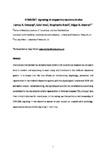GDNF/RET signaling in dopamine neurons in vivo
| dc.contributor.author | Conway, James | |
| dc.contributor.author | Ince, S | |
| dc.contributor.author | Black, Stephanie | |
| dc.contributor.author | Kramer, Edgar | |
| dc.date.accessioned | 2020-10-16T12:56:36Z | |
| dc.date.issued | 2020-09-01 | |
| dc.identifier.issn | 0302-766X | |
| dc.identifier.issn | 1432-0878 | |
| dc.identifier.uri | http://hdl.handle.net/10026.1/16547 | |
| dc.description.abstract |
The glial cell line-derived neurotrophic factor (GDNF) and its canonical receptor Ret can signal both in tandem and separately to exert many vital functions in the midbrain dopamine system. It is known that Ret has effects on maintenance, physiology, protection and regeneration in the midbrain dopamine system, with the physiological functions of GDNF still somewhat unclear. Notwithstanding, Ret ligands, such as GDNF, are considered as promising candidates for neuroprotection and/or regeneration in Parkinson's disease, although data from clinical trials are so far inconclusive. In this review, we discuss the current knowledge of GDNF/Ret signaling in the dopamine system in vivo as well as crosstalk with pathology-associated proteins and their signaling in mammals. | |
| dc.format.extent | 135-146 | |
| dc.format.medium | Print-Electronic | |
| dc.language | en | |
| dc.language.iso | en | |
| dc.publisher | Springer Science and Business Media LLC | |
| dc.subject | Midbrain dopamine system | |
| dc.subject | Cell survival | |
| dc.subject | Protection | |
| dc.subject | Regeneration | |
| dc.subject | Ret | |
| dc.subject | GDNF | |
| dc.title | GDNF/RET signaling in dopamine neurons in vivo | |
| dc.type | journal-article | |
| dc.type | Journal Article | |
| dc.type | Review | |
| plymouth.author-url | https://www.webofscience.com/api/gateway?GWVersion=2&SrcApp=PARTNER_APP&SrcAuth=LinksAMR&KeyUT=WOS:000565098900001&DestLinkType=FullRecord&DestApp=ALL_WOS&UsrCustomerID=11bb513d99f797142bcfeffcc58ea008 | |
| plymouth.issue | 1 | |
| plymouth.volume | 382 | |
| plymouth.publication-status | Published | |
| plymouth.journal | Cell and Tissue Research | |
| dc.identifier.doi | 10.1007/s00441-020-03268-9 | |
| plymouth.organisational-group | /Plymouth | |
| plymouth.organisational-group | /Plymouth/Faculty of Arts, Humanities and Business | |
| plymouth.organisational-group | /Plymouth/Faculty of Arts, Humanities and Business/School of Art, Design and Architecture | |
| plymouth.organisational-group | /Plymouth/Faculty of Health | |
| plymouth.organisational-group | /Plymouth/Faculty of Health/Peninsula Medical School | |
| plymouth.organisational-group | /Plymouth/Faculty of Science and Engineering | |
| plymouth.organisational-group | /Plymouth/REF 2021 Researchers by UoA | |
| plymouth.organisational-group | /Plymouth/REF 2021 Researchers by UoA/UoA01 Clinical Medicine | |
| plymouth.organisational-group | /Plymouth/REF 2021 Researchers by UoA/UoA32 Art and Design: History, Practice and Theory | |
| plymouth.organisational-group | /Plymouth/Users by role | |
| plymouth.organisational-group | /Plymouth/Users by role/Academics | |
| dc.publisher.place | Germany | |
| dcterms.dateAccepted | 2020-07-23 | |
| dc.rights.embargodate | 2021-9-1 | |
| dc.identifier.eissn | 1432-0878 | |
| dc.rights.embargoperiod | Not known | |
| rioxxterms.versionofrecord | 10.1007/s00441-020-03268-9 | |
| rioxxterms.licenseref.uri | http://www.rioxx.net/licenses/all-rights-reserved | |
| rioxxterms.licenseref.startdate | 2020-09-01 | |
| rioxxterms.type | Journal Article/Review |


